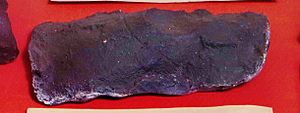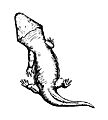Deltasaurus facts for kids
Quick facts for kids DeltasaurusTemporal range: Late Triassic
|
|
|---|---|
 |
|
| Restoration of Deltasaurus kimberleyensis | |
| Scientific classification |
|
| Kingdom: | Animalia |
| Phylum: | Chordata |
| Order: | †Temnospondyli |
| Suborder: | †Stereospondyli |
| Family: | †Rhytidosteidae |
| Subfamily: | †Derwentiinae |
| Genus: | †Deltasaurus Cosgriff, 1965 |
| Type species | |
| †Deltasaurus kimberleyensis Cosgriff, 1965
|
|
| Other species | |
|
|
Deltasaurus was an extinct amphibian that lived a very long time ago. It was part of a group called temnospondyls. These animals were like a mix between a salamander and a crocodile.
Deltasaurus lived during the Triassic period, specifically in the Carnian age. This was about 237 to 227 million years ago! It belonged to a family of amphibians called Rhytidosteidae.
Contents
Discovering Deltasaurus
Scientists first learned about Deltasaurus in 1965. A scientist named John W. Cosgriff described two new species. He found their fossils in northwest Australia.
Where Fossils Are Found
Deltasaurus fossils are quite common in a place called the Blina Shale. This is a special rock deposit in the Kimberley region of Western Australia. It's like a treasure chest of ancient animal remains.
A fossil of Deltasaurus has also been found in Tasmania. This shows that these amphibians lived in different parts of ancient Australia.
Different Types of Deltasaurus
There are two known species of Deltasaurus:
- Deltasaurus kimberleyensis: This is the main type of Deltasaurus. It could grow to about 90 centimeters long. That's almost a meter, or about the length of a baseball bat!
- Deltasaurus pustulatus: This species was also described by Cosgriff in 1965.
What Deltasaurus Looked Like
Deltasaurus was an amphibian with four legs and a tail. It had many tiny teeth in its mouth. Scientists think it was a predator, meaning it hunted and ate other animals. It probably ate fish.
One special thing about Deltasaurus was the shape of its skull. Unlike some other related amphibians from Australia, Deltasaurus had a skull with straight sides. Other similar amphibians had skulls that were more curved or parabolic.
Images for kids



